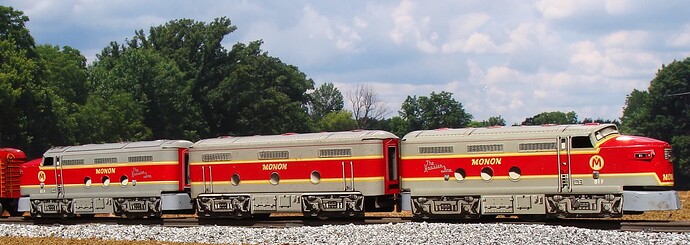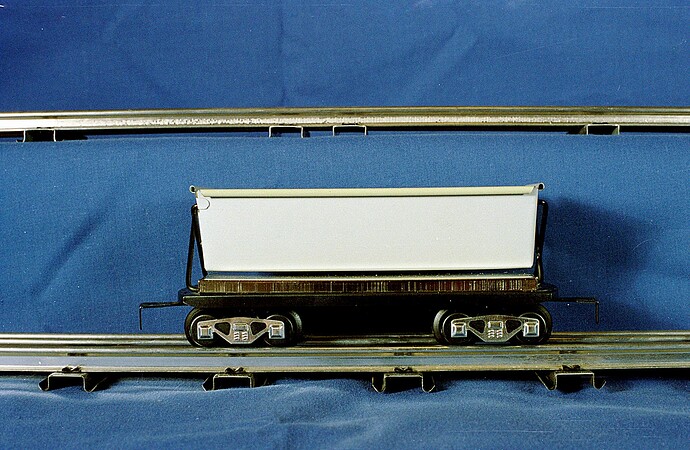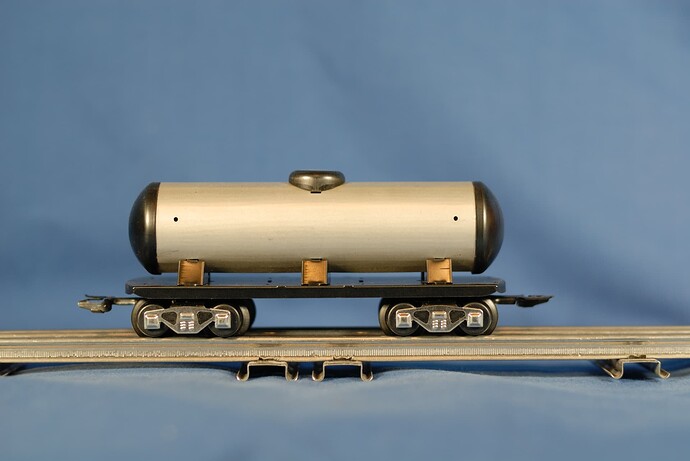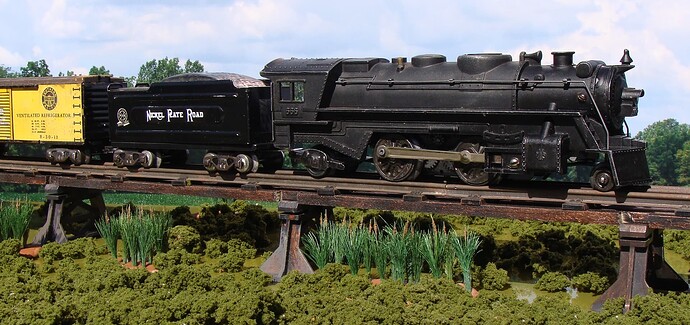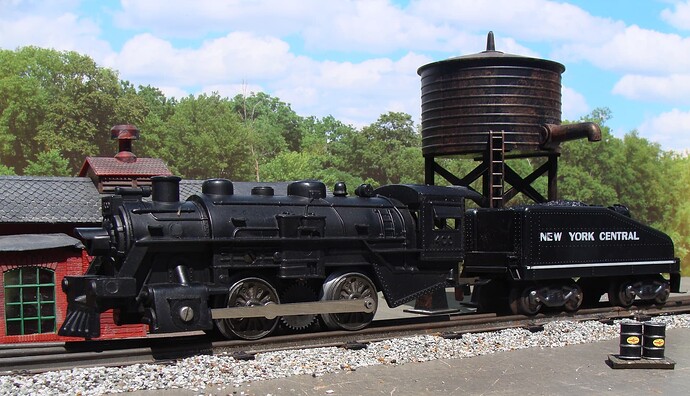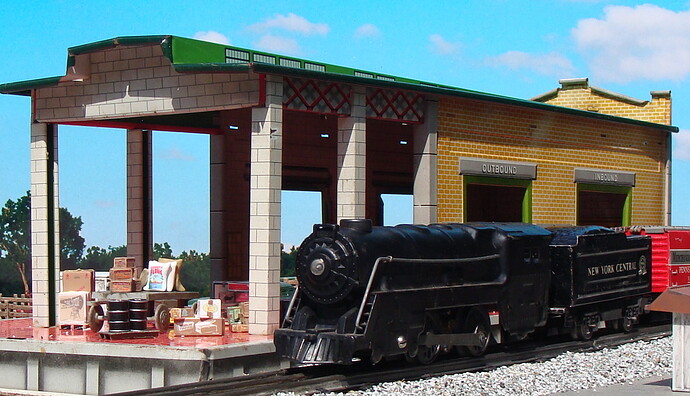Scrap?
Not on my railroad!
Yes! That’s the later short tank version that’s just the HO tank on a higher base. The original O-S tank was almost twice as tall and while still a bit small as far as water holding potential goes, it at least looked better than the budget cutting short tank for all 3 scales model.
I’d be rather curious to hear the story behind these ‘scrap’ litho cars/why they were made, if you happen to know it.
-El
Man, if that’s scrap it’s the classiest-lookin’ scrap I’ve ever seen! Wow! ![]()
Marx only sold its Fairbanks-Morse diesels in A-A or A-B combinations. With a little ingenuity, it is possible to come up with an A-B-A combination like this one.
flintlock76 and El_Fixes the cars are all tool test cars made from scrap CP passenger car litho sheets. It’s standard practice to run test shots through production machinery before beginning actual production to make sure the machines are working properly. These cars were test shots for various New Marx stamping/cutting/forming machines to which the Flynn’s added frames and wheels and offered for sale on e-bay many years ago.
My first purchase was the tank car which I thought would be a neat item for running and for toy train discussions. Sometime later the Flynn’s offered the caboose in the same format (which I bought) and it was then I decided if they continued and offered other cars like this I would try to get a few and put together a “scrap” train.
As you can see, they did. Once I had the cars I purchased one of their standard production CP engines and assembled my “set.”
I don’t remember how many of these cars they offered on e-bay but I do recall they offered some in 8 wheel and some in 4 wheel configurations and they showed up every now and then on e-bay over the course of a couple of years.
I hadn’t thought of that! Makes a lot of sense. I guess they had a lot of scrap CP passenger car sheets to go through. I quite like that there is an actual ‘purpose’ for their existence, besides being an oddity for collectors to seek out. Thank you very much for sharing!
-El
Actually it wasn’t unusual for the original Marx company either. I’ve seen shells made from WW2 era rationing canister steel. Not Marx but I had a Hafner loco that was lettered for Philadelphia cream cheese inside the shell.
Fantastic photo and back story. You have to love ebay for providing a venue for these items. There are still similar items and things from the New Marx archives that are showing up. Some are originally from the archives that are being sold by their first owners. I keep my eyes open.
Thanks mersenne6
Northwoods Flyer
Neat
Wow, that makes them an even more incredible collectible! You’d think the test cars would have been consigned to oblivion once the tests were done but happily not in this case! I AM amazed!
Yes, re-cycled litho sheets isn’t exactly unusual. what is odd, is that in my experience what you usually see is the ‘scrap’ graphics are on the inside of a piece, with the intended lithography for the piece facing outwards.
Wheras the Canadian Pacific rolling stock shows the scrap litho on the outside, where intended graphics might normally have gone. This was my first time seeing anything done this way.
I myself have a tin piece or two with re-used litho tinplate, where one can look inside the item to see the repurposed scrap lithography.
-El
There are other reasons for putting the scrap litho on the outside of the test cars. It made it easier to spot small defects in the setup which would result surface scratches or nicks of any kind which could be corrected before the beginning of actual production. The Flynn’s also made test shots using regular but unlithoed sheet stock.
Here’s an example
and they used raw sheet stock as well
I can see the passenger litho now!
My 3/16 scale Nickel Plate train is headed up by a 666 locomotive. The 8-wheel NKP “wedge” tender is a custom job. Marx did make a limited number of 4-wheel NKP “wedge” tenders for a special set ordered by Sears, but never made an 8-wheel NKP “wedge.”
I thought they were racing stripes until I enlarged the photo ![]()
When I started collecting Marx items 11 years ago, it was with the intention of using Marx rolling stock and accessories to create approximations of the rail fan photos from the 1940s and 1950s that are seen in books like Don Ball, Jr.’s AMERICA’S COLORFUL RAILROADS.
Locomotives made of shiny black plastic were useless to me since, no matter how I tried to stage them, they still looked like the toys they were, completely ruining the illusion of reality I was trying to create. (I almost gave up on my Marx 1829 4-6-4 locomotive for this reason. Fortunately, I thought to send it to Baldemar Manzo, who custom-painted it to make it appear as if it was a die-cast locomotive. It is now one of my favorite items to photograph.)
Although I’m no Baldemar Manzo, I was reasonably successful in spray painting my Marx 400 locomotive flat black which, IMHO, improved its appearance immensely. (Others might find doing this an act of sacrilege.)
Marx never made an 0-4-0 “switcher” locomotive similar to Lionel’s 1615 . My flat black 400 now fills that role nicely. I’ve matched it up with a “slope back” tender. (These were used on work trains and yard engines to give the engineer a better view to the rear.)
Not as far as I’m concerned, it’s your engine after all.
In fact it wasn’t unusual for steam locomotive manufacturers like Baldwin, Alco, and Lima to paint new lcomotives with a flat black or dark grey paint for their official photograph as the flat finish photographed much better than the standard glossy one. So you’re being prototypical!
The 1955 Sears Christmas Wishbook listed a Marx Freight Station bundle that included a five-unit freight set headed up by 591 locomotive, all for $14.79 or about $177 in today’s dollars. (The freight items shown in this image are from Woodland Scenics.)
I was sad to sell my freight station, but it was too big for my layout. Hopefully someone is enjoying it now, because those are really neat IMHO
